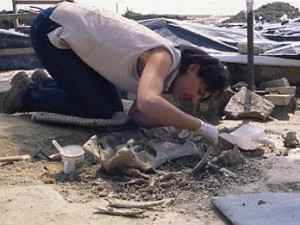 The Archaeozoology or Zooarchaeology is the discipline that studies the faunal remains recovered in archaeological sites, which consists mainly of skeletal parts of vertebrates and invertebrates in coatings and shells.
The Archaeozoology or Zooarchaeology is the discipline that studies the faunal remains recovered in archaeological sites, which consists mainly of skeletal parts of vertebrates and invertebrates in coatings and shells.
These materials are stored, analyzed, measured and counted on a statistical basis, providing interesting data on the age and death of organisms, about the size of the different species. From the data acquired a lot of information can be deduced about the relationships between humans and animals.
The skeletal remains of vertebrates, especially mammals, are obviously the most resistant materials and then those found in the majority. In prehistoric sites (Paleolithic and Mesolithic), these stem from the hunting and gathering conducted by humans, providing interesting information on nutrition and slaughter techniques. The findings may also provide information on the environmental context in which humans lived. In particular, very small remains resulting from the sieving of sediments, such as small mammals and continental molluscs, because they give us useful paleoecological and chrono-stratigraphic information.
From the Neolithic age, hunting and gathering activities were reduced. Farmed animals became dominant as well as the process of domestication. Archaeozoological analysis give us information about the breeds and the economy of the site in relation to the exploitation of animals.
Other topics of study are related to specific findings, such as those used as instruments or objects of art, activities and sacred rituals, and to the study of changes produced by humans.
In the Natural History Museum of Venice there is a specific section dedicated to Archaeozoology, with a rich collection of findings. The vocation of this archaeozoological section is mainly the study and exploitation of materials from local excavations (Venice and the mainland), but there are also collaboration with other institutions of the rest of Italy. Among the activities of the section archaeozoological must be recalled the laboratory, playing a central role in preservation and restoration of the excavated material.
There are numerous institutions that rely to the Museum for scientific support. Among the others, the local Archaeological Superintendency, the National Museum of Altino and the Department of Ancient History and Near Eastern Studies of the University Ca ‘Foscari of Venice.